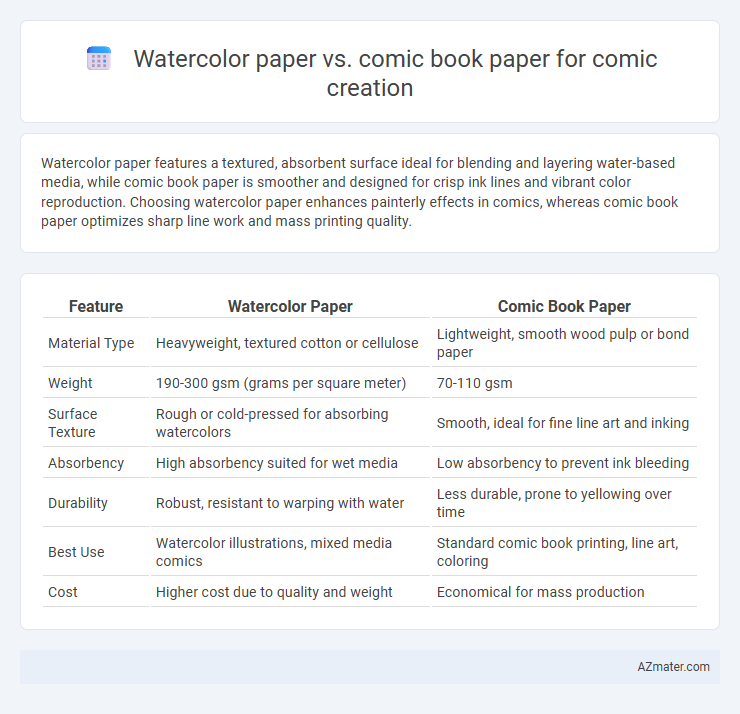Watercolor paper features a textured, absorbent surface ideal for blending and layering water-based media, while comic book paper is smoother and designed for crisp ink lines and vibrant color reproduction. Choosing watercolor paper enhances painterly effects in comics, whereas comic book paper optimizes sharp line work and mass printing quality.
Table of Comparison
| Feature | Watercolor Paper | Comic Book Paper |
|---|---|---|
| Material Type | Heavyweight, textured cotton or cellulose | Lightweight, smooth wood pulp or bond paper |
| Weight | 190-300 gsm (grams per square meter) | 70-110 gsm |
| Surface Texture | Rough or cold-pressed for absorbing watercolors | Smooth, ideal for fine line art and inking |
| Absorbency | High absorbency suited for wet media | Low absorbency to prevent ink bleeding |
| Durability | Robust, resistant to warping with water | Less durable, prone to yellowing over time |
| Best Use | Watercolor illustrations, mixed media comics | Standard comic book printing, line art, coloring |
| Cost | Higher cost due to quality and weight | Economical for mass production |
Introduction: Choosing the Right Paper for Comics
Watercolor paper offers textured surfaces ideal for rich ink absorption and vibrant watercolor effects, enhancing comic illustrations with depth and detail. Comic book paper, typically smooth and lightweight, supports crisp line art and efficient mass production with inkjet and marker compatibility. Selecting the right paper depends on the desired artistic style, durability, and printing methods for the final comic creation.
Overview: Watercolor Paper Characteristics
Watercolor paper features a textured surface designed to absorb water-based pigments, providing rich color blending and depth essential for detailed comic artwork. Its archival-quality cotton fibers ensure durability and resistance to warping during heavy ink or paint application, making it ideal for mixed media comic creation. This paper's thickness and absorbency allow vibrant watercolor washes without bleeding, enhancing the visual impact of comics that incorporate painted elements.
Overview: Comic Book Paper Attributes
Comic book paper is specifically designed to handle ink absorption and maintain sharp line details, featuring a smooth, coated surface that prevents excessive bleeding. Typically thinner and lighter than watercolor paper, it supports high-quality printing and vibrant color reproduction essential for comics. Its durability allows for extensive handling during production without compromising image clarity or color integrity.
Surface Texture: Smoothness vs. Tooth
Watercolor paper typically features a pronounced tooth, offering a textured surface that enhances ink absorption and color blending for dynamic comic illustrations. Comic book paper is generally much smoother, designed to allow crisp, clean lines and sharp details ideal for mass printing. Choosing between these surfaces depends on the desired artistic effect: watercolor paper lends a tactile, painterly quality, while comic book paper ensures precise line work and consistent print reproduction.
Ink and Color Absorption Differences
Watercolor paper features a textured surface with high absorbency, allowing it to hold water-based inks and vibrant colors without bleeding, making it ideal for detailed color layering in comic creation. Comic book paper, typically smooth and less porous, is designed to handle rapid ink drying from pens and markers but can cause colors to sit on the surface, leading to potential smudging or less vibrant hues. Ink absorption on watercolor paper enhances depth and blending, whereas comic book paper prioritizes crisp line work but may require multiple passes for vivid color saturation.
Durability and Handling Over Time
Watercolor paper offers superior durability and resists warping and deterioration over time, making it ideal for long-lasting comic art that requires frequent handling. Comic book paper, typically thinner and less robust, is more prone to yellowing, tearing, and damage during repeated use or storage. For creators prioritizing longevity and preservation, watercolor paper significantly outperforms standard comic book paper in maintaining artwork integrity.
Compatibility with Art Supplies: Pens, Markers, and Paints
Watercolor paper offers superior compatibility with wet media such as watercolor paints and ink washes, providing excellent absorption and preventing bleeding, which is ideal for artists using pens, markers, and water-based paints in comic creation. Comic book paper, typically made from thinner, less textured stock, performs well with dry media like ballpoint pens and some markers but often struggles with wet paints, leading to warping or smudging. Choosing watercolor paper enhances durability and color vibrancy for mixed media techniques, while comic book paper favors fast-drying, dry ink applications and standard printing processes.
Cost Comparison: Budget Considerations
Watercolor paper typically costs more per sheet compared to comic book paper due to its thickness and texture, which are designed to handle heavy washes and prevent warping. Comic book paper is more affordable and optimized for ink absorption and crisp line work, making it a budget-friendly option for large volume comic production. For artists prioritizing cost efficiency, especially in high-output projects, comic book paper offers a significant advantage without compromising print quality.
Common Usage Scenarios and Recommendations
Watercolor paper offers a textured, absorbent surface ideal for vibrant, detailed washes and mixed media techniques in comic creation, making it suitable for artists emphasizing painterly effects or color layering. Comic book paper, typically smooth and lightweight, is optimized for ink clarity and sharp line work, favored for traditional pen-and-ink styles and mass reproduction in printed comics. Artists seeking durability and rich color blending should opt for watercolor paper, while those prioritizing clean line art and ease of scanning benefit from comic book paper.
Conclusion: Which Paper Suits Your Comic Style?
Watercolor paper features a textured, absorbent surface ideal for detailed, vibrant washes and painterly comic styles, offering excellent durability for mixed media and wet applications. Comic book paper is smoother, thinner, and designed for sharp ink lines, precise coloring, and mass production, making it perfect for traditional line art and digital coloring workflows. Choose watercolor paper for expressive, painterly comics with heavy use of water-based media, while comic book paper suits crisp, clean artwork and efficient printing needs.

Infographic: Watercolor paper vs Comic book paper for Comic creation
 azmater.com
azmater.com